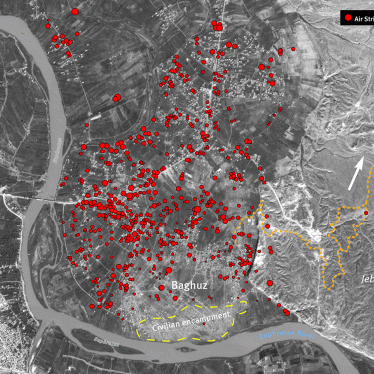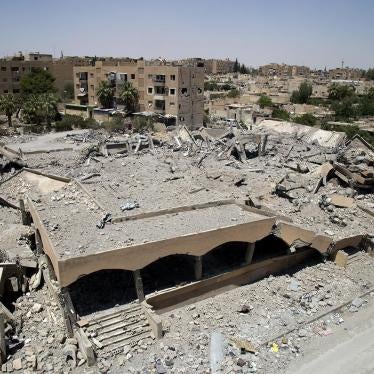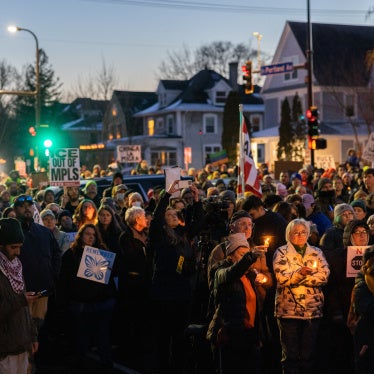(New York) – Credible evidence has emerged that Islamic State forces used ground-fired cluster munitions in at least one location in northern Syria in recent weeks. The use of cluster munitions by non-state actors such as the Islamic State shows the urgent need for Syria and all nations that have not yet done so to join the ban on cluster munitions and destroy their stockpiles.
Syrian government forces have used cluster munitions since June 2012 despite widespread international condemnation. An attack on August 21 is the most recent report of government use.
“Any use of cluster munitions deserves condemnation, but the best response is for all nations to join the treaty banning them and work collectively to rid the world of these weapons,” said Steve Goose, arms division director at Human Rights Watch and chair of the Cluster Munition Coalition (CMC).
Cluster munition use in Syria in 2014 – as well as in Ukraine, and South Sudan – will be considered by governments at the treaty’s fifth annual meeting in San Jose, Costa Rica, from September 2 through 5, 2014. Syria, Ukraine, and South Sudan have not joined the treaty.
Based on reports of local Kurdish officials and photographic evidence, forces of the Islamic State, formerly the Islamic State of Iraq and Sham (ISIS), used cluster munitions on July 12 and August 14 during fighting around the Syrian town of `Ayn al-`Arab, also known as Kobani in Kurdish, in Aleppo governorate near Syria’s northern border with Turkey. The area is under the control of Kurdish forces from the People’s Protection Units (YPG).
A senior Kurdish official from the town told Human Rights Watch that four YPG combatants and an 11-year-old child had been killed in the two attacks, which also wounded a child. This is believed to be the first known use of cluster munitions by the Islamic State, which has been fighting the YPG and other non-state armed groups in the area for over a year. Human Rights Watch does not know how the Islamic State acquired these cluster munitions.
Recent use of air-delivered cluster munitions by Syrian government forces include an August 21 attack on the town of Manbij in Aleppo governorate, which has been under the control of the Islamic State since the beginning of the year. According to an organization working in the town, the attack killed at least six civilians and wounded 40 more.
Syrian government forces have used at least 249 cluster munitions since mid-2012 in multiple locations in 10 of Syria’s 14 governorates, based on video and film evidence, witness accounts, and research by Human Rights Watch and others. The actual number is probably much higher as not all instances of use have been recorded.
Data collected by Cluster Munition Monitor 2014 – the annual survey issued by the Cluster Munition Coalition on August 27 – shows that there were at least 1,584 casualties from cluster munition attacks and unexploded submunitions in Syria in 2012 and 2013, while hundreds more were recorded in the first half of 2014. The vast majority of those identified as killed – 97 percent – were civilians.
Syrian government forces have used cluster munitions since June 2012 despite widespread international condemnation. More than 140 countries have condemned Syria’s use of cluster munitions in statements and resolutions, including 51 that have not joined the Convention on Cluster Munitions.
Cluster munitions can be fired by rockets, mortars, and artillery or dropped by aircraft. They explode in the air, sending dozens, even hundreds, of submunitions or “bomblets” over a wide area. These submunitions often fail to explode on initial impact, leaving duds that act like landmines and explode when handled.
All parties to the conflict in Syria should immediately halt the use of cluster munitions and make a commitment not to use these weapons, which have been banned by most of the world’s nations. Syria should accede to the 2008 Convention on Cluster Munitions without delay and destroy its stocks of the weapons. The UN Security Council should impose an arms embargo on the Syrian government and other armed groups that commit systematic or widespread rights abuses.
For details of the attacks and an update about cluster munitions use, please see below.
Apparent Islamic State Cluster Munition Use in `Ayn al-`Arab/Kobani
Kurdish authorities in `Ayn al-`Arab/Kobani have provided photographs and information to Human Rights Watch that strongly indicates that Islamic State forces have used cluster munitions in recent weeks during attacks on the area. On August 15, the local government of Kobani issued a media advisory warning the local population of the danger posed by cluster munition remnants that it said were “fired by Daash [ISIS] mercenaries on villages” near `Ayn al-`Arab/Kobani.
According to the statement and information provided to Human Rights Watch by a senior Kurdish official in `Ayn al-`Arab/Kobani, cluster munitions were used in an Islamic State attack on the village of Cevi, south of `Ayn al-`Arab/Kobani, on August 14. The next day, two boys, ages eight and 11, handled a small cylindrical submunition with a bright red ribbon that detonated, killing the 11-year-old and wounding the eight-year-old, the official said.
The `Ayn al-`Arab/Kobani authorities provided photographs of the rocky field outside Cevi where the child was killed that show more than a dozen submunitions with red nylon stabilizing ribbons attached. From their markings, the submunitions are the type known as “ZP-39,” but its producer and the delivery system used are not publicly known or included in standard international reference materials.
Dual-purpose improved conventional munition (DPICM) submunitions such as the “ZP-39” are “spin-armed” and rely on the physical forces from a ground fired artillery projectile or rocket to deploy properly. Delivery by aircraft would not provide sufficient spin to arm a DPICM submunition.
Syrian government forces do not have troops in the `Ayn al-`Arab/Kobani region, and there have been no known government airstrikes in the area, making it unlikely that this attack was by government forces, Human Rights Watch said. The Kurdish official in `Ayn al-Arab/Kobani told Human Rights Watch that the YPG does not have any cluster munitions to use. Human Rights Watch has not found evidence or heard allegations that would indicate YPG forces have these weapons.
Markings on the submunitions indicate they were manufactured in 1992. The same type of “ZP-39” submunition with markings showing a manufacture date of 1993 were filmed in what was reported to be the village of Maliha in rural Damascus on April 4 and the town of al-Waziyeh southeast of Homs on July 22, but the party responsible for their use could not be identified.
According to the Kurdish official, four YPG combatants died from another ISIS attack in the same area involving the use of the same type of submunitions on July 12, but Human Rights Watch was not able to corroborate whether this attack took place and the number of fatalities.
Apparent Government Use of Cluster Munitions in Manbij
Cluster munitions appear to have been used on August 21 by Syrian government forces in the town of Manbij in Aleppo governorate, located near the Euphrates River northeast of Aleppo city and northwest of Raqqa, according to a non-partisan organization working in the city that provided information to Human Rights Watch. Human Rights Watch has reviewed photographs taken by local people of the cluster munition remnants from the attack that show PTAB-2.5KO and AO-2.5RT submunitions. These submunitions can only be released from a dispenser scattered by fixed-wing aircraft or by helicopter.
While government forces, the Islamic State, and other non-state armed groups are all fighting in Manbij, only the government has airpower. The organization in Manbij said that local residents reported that the August 21 attack killed at least six civilians and wounded another 40. Two members of a family living next to Bayram School reportedly died in the attack, while four other civilians were reported killed in the Hawazneh neighborhood, the organization said. Human Rights Watch has not been able to independently verify the number of casualties or their names.
Human Rights Watch has previously documented government use of both types of submunitions, which are released from a dispenser scattered by fixed-wing aircraft or by helicopter.
Cluster Munition Update
The 2008 Convention on Cluster Munitions, which comprehensively bans cluster munitions, requires destruction of stockpiles, clearance of areas contaminated by cluster munition remnants, and assistance to victims. A total of 84 countries are party to the Convention on Cluster Munitions, which came into force on August 1, 2010, while another 29 have signed but not yet ratified.
Cluster Munition Monitor 2014 recorded new use of cluster munitions in South Sudan and Ukraine in the first half of 2014, but it is not yet clear who was responsible. A May UN Security Council resolution on South Sudan expressed serious concern about the use of cluster munitions, while Russia criticized the use of cluster munitions against civilians in eastern Ukraine on several occasions in July.
Human Rights Watch is a founding member of the international Cluster Munition Coalition, the civil society campaign behind the Convention on Cluster Munitions and publisher of Cluster Munition Monitor 2014.







